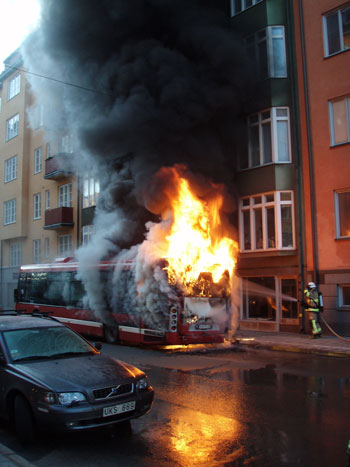New standard for fire suppression systems in engine compartments of buses and coaches finally published
- Like
- Digg
- Del
- Tumblr
- VKontakte
- Buffer
- Love This
- Odnoklassniki
- Meneame
- Blogger
- Amazon
- Yahoo Mail
- Gmail
- AOL
- Newsvine
- HackerNews
- Evernote
- MySpace
- Mail.ru
- Viadeo
- Line
- Comments
- Yummly
- SMS
- Viber
- Telegram
- Subscribe
- Skype
- Facebook Messenger
- Kakao
- LiveJournal
- Yammer
- Edgar
- Fintel
- Mix
- Instapaper
- Copy Link
Posted: 9 October 2012 | SP | No comments yet
New standard for fire suppression systems developed…


The Fire Brigade tackle a bus fire in Stockholm / Niklas Nordenskär
SP Technical Research Institute of Sweden has developed a new standard for fire suppression systems in engine compartments of buses and coaches. This work has been carried out in part on behalf of the National Road Authority in Sweden. The objective has been to construct a model of an engine compartment where stakeholders can evaluate the firefighting performance of different suppression systems in a well-defined and objective way. Edition 3 of the new standard SP method 4912 has just been published.


The Fire Brigade tackle a bus fire in Stockholm / Niklas Nordenskär
A Reference Group has provided valuable input and know-how to the standards development. International representatives from suppression manufacturers, insurance companies, bus associations, transit authorities and bus manufacturers have contributed.
The main objective of the research leading up to the standard development has been the promulgation of this standard at the UNECE Working Group on General Safety Provisions (GRSG) in Geneva (http://www.unece.org/trans/main/welcwp29.html). Should the standard be accepted in this forum, fire suppression systems will be required to be installed in buses and coaches. In parallel, SP has established a voluntary certification/quality mark for the industry – the P-mark – according to SPCR 183 (SP Certification Rules) due to the fact that progress through the GRSG can be protracted. A P-mark certifies that the product meets the requirements of relevant standards, regulations etc., and that the manufacturer or importer operates an approved inspection and quality control scheme.
To obtain a P-mark in accordance with SPCR 183, the fire suppression system will need to fulfil the requirements of SP method 4912 in which the capacity of the system to extinguish different types of fires is evaluated. In addition, testing of all components as part of the system is also required. This means that detectors, electrical/electronic components and control panels will be performance tested for harsh environments, EMC, temperature and humidity extremes, etc.
Transit Authorities can now start citing P-marked systems in accordance with SPCR 183 in their technical requirements for procurement of fire suppression systems.
Related organisations
SP Technical Research Institute of Sweden



